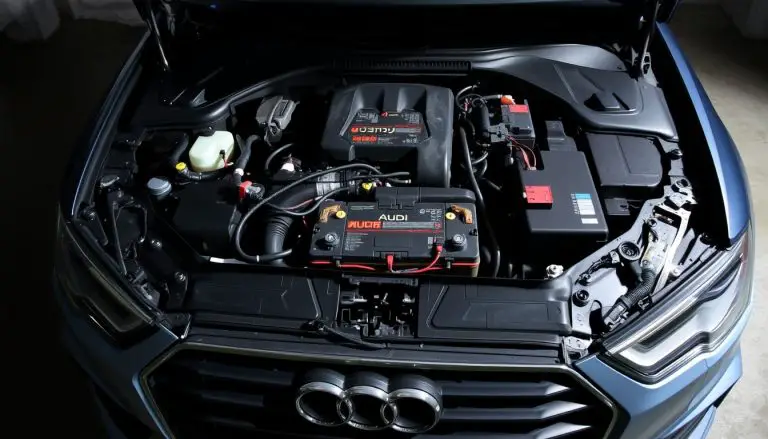When your Audi vehicle goes into limp mode, it’s a sign that the onboard computer has detected a problem that could potentially damage the engine or transmission. This protective mechanism limits engine performance to prevent further damage. Understanding the causes and symptoms of limp mode is crucial for effective diagnosis and repair.
Our comprehensive guide is designed to help Audi owners understand, diagnose, and repair limp mode issues. By following this guide, you’ll be able to identify the root cause of the problem and take the necessary steps to resolve it, getting your vehicle back to normal operating conditions.
Key Takeaways
- Understanding the causes and symptoms of limp mode in your Audi.
- Step-by-step guide to diagnosing limp mode issues.
- Repair strategies to resolve limp mode problems.
- Preventive measures to avoid future limp mode occurrences.
- Importance of regular maintenance to minimize the risk of limp mode.
Understanding Audi Limp Mode
Limp mode is a protective mechanism implemented in Audi cars to prevent engine damage. When the engine control unit (ECU) detects a potential issue, it activates limp mode, limiting the vehicle’s performance to prevent further damage.
What Is Limp Mode and Why It Activates
Limp mode, also known as “limp home mode,” is a safety feature designed to allow the vehicle to continue operating, albeit with reduced performance, when a fault is detected. For more information on limp mode, you can visit this guide. It activates when the ECU identifies a problem that could cause harm to the engine, such as issues with the transmission, engine sensors, or other critical components.
How Limp Mode Protects Your Audi’s Engine
By limiting engine performance, limp mode helps prevent potential damage that could result from continued operation with a fault. This protective measure can help avoid costly repairs by reducing strain on the engine.
Differences Between Limp Mode and Other Performance Issues
Unlike other performance issues that might cause a vehicle to stall or lose power intermittently, limp mode is characterized by a consistent reduction in performance. Understanding these differences is crucial for diagnosing and addressing the underlying causes.
Common Symptoms of Audi Limp Mode
Limp mode in Audi vehicles is characterized by distinct symptoms that drivers should be aware of to address potential problems early. These symptoms are designed to alert the driver to potential issues that could cause significant damage if left unaddressed.
Performance Limitations and Reduced Power
One of the primary indicators of limp mode is a noticeable reduction in engine power. This can manifest as sluggish acceleration or an inability to maintain normal speeds, particularly when merging onto highways or climbing steep inclines.
Dashboard Warning Lights and Error Messages
The dashboard serves as a critical interface for communicating limp mode activation to the driver. Warning lights such as the check engine light or specific error messages related to engine or transmission issues are common indicators.
Transmission Behavior Changes
Limp mode can also affect transmission behavior, leading to abrupt or delayed shifting. This can result in a jerky or hesitant driving experience, further indicating that the vehicle is not operating within normal parameters.
Engine Performance Indicators
Various engine performance indicators may be affected when an Audi is in limp mode. These can include unusual vibrations, stalling, or an inconsistent idle, all of which signal that the engine is not running as it should.
Diagnosing and Fixing Audi Limp Mode Issues
Diagnosing Audi limp mode issues requires a comprehensive approach, involving the right diagnostic tools and a thorough understanding of the vehicle’s systems. To effectively address limp mode, it’s essential to identify the root cause of the problem.
Essential Diagnostic Tools for Audi Vehicles
Audi diagnostic tools play a crucial role in identifying the causes of limp mode. The most common tool used is the OBD-II scanner, which can retrieve error codes stored in the vehicle’s onboard computer.
Using OBD-II Scanners for Accurate Diagnosis
OBD-II scanners are designed to communicate with the vehicle’s Engine Control Module (ECM) to retrieve diagnostic trouble codes (DTCs). These codes provide valuable information about the issue causing limp mode.
Interpreting Audi-Specific Error Codes
Audi-specific error codes can be categorized into two main types: P-codes and manufacturer-specific codes.
Common P-Codes Related to Limp Mode
- P0121: Throttle Position Sensor Circuit Range/Performance
- P0171: System Too Lean (Bank 1)
- P0300: Random/Multiple Cylinder Misfire Detected
Manufacturer-Specific Codes
Audi vehicles also use manufacturer-specific codes that require specialized diagnostic equipment to interpret. These codes often relate to specific systems or components unique to Audi models.
By understanding and interpreting these error codes, technicians can accurately diagnose the issue causing limp mode and perform the necessary repairs. This process not only resolves the immediate problem but also helps prevent future issues.
Common Causes of Limp Mode in Audi Vehicles
Understanding the root causes of limp mode is crucial for Audi owners to address the issue effectively. Limp mode is a protective feature that limits engine performance to prevent damage when the vehicle’s computer detects a problem. Several factors can trigger this mode, and identifying them is key to resolving the issue.
Transmission Control Module Problems
The Transmission Control Module (TCM) plays a vital role in managing the transmission’s operation. Issues with the TCM, such as software glitches or hardware failures, can cause the vehicle to enter limp mode. Faulty TCMs can lead to erratic transmission behavior, including slipping, hesitation, or failure to engage gears properly.

Sensor Failures (MAF, MAP, O2 Sensors)
Sensor failures are another common cause of limp mode in Audi vehicles. The Mass Airflow (MAF) sensor, Manifold Absolute Pressure (MAP) sensor, and Oxygen (O2) sensors provide critical data to the engine control unit. When these sensors malfunction, they can send incorrect signals, triggering limp mode. For instance, a faulty MAF sensor can cause the engine to run rich or lean, leading to performance issues.
Turbocharger and Boost Pressure Issues
Turbocharger problems can also activate limp mode, particularly in turbocharged Audi models. Issues such as turbocharger failure, boost pressure leaks, or wastegate problems can cause the engine to lose power or run inefficiently, prompting the vehicle’s computer to limit performance.
Electrical System and Wiring Faults
Electrical system faults, including wiring issues or connector problems, can disrupt communication between the vehicle’s various control modules. This can lead to limp mode as the vehicle’s computer attempts to protect the engine and transmission from potential damage.
Cooling System Problems
Cooling system malfunctions, such as a faulty thermostat, coolant leak, or failing water pump, can cause the engine to overheat. When the engine control unit detects overheating, it can activate limp mode to reduce engine load and prevent damage.
Step-by-Step Repair Guide for Common Limp Mode Triggers
Once you’ve identified the reason for limp mode activation, you can proceed with the appropriate repairs to get your Audi running smoothly again. This section will guide you through the process of addressing common issues that trigger limp mode.
Resetting Limp Mode After Diagnosis
After diagnosing the issue, the first step is often to reset the limp mode. This can be done using an OBD-II scanner. For a detailed guide on resetting your Audi’s computer, you can refer to this resource. Resetting limp mode doesn’t fix the underlying issue but allows you to test if the problem persists.
Replacing Faulty Sensors and Components
Faulty sensors are a common cause of limp mode. Replacing them involves identifying the specific sensor causing the issue, such as the MAF, MAP, or O2 sensors. Ensure you purchase the correct replacement part for your Audi model.
Addressing Boost Pressure and Turbo Problems
Turbocharger issues can trigger limp mode. Inspect the turbocharger for signs of wear or damage. Checking boost pressure and ensuring that the wastegate is functioning correctly is crucial.
Fixing Transmission-Related Issues
Transmission problems can also cause limp mode. Inspecting the transmission fluid level and condition is a good starting point. If the issue persists, further diagnosis may be required to identify faulty solenoids or other transmission components.
Resolving Wiring and Connector Problems
Wiring and connector issues can lead to limp mode. Inspecting the wiring harness for damage or corrosion and checking connectors for proper connection is essential. Repairing or replacing damaged wiring or connectors can resolve the issue.
| Issue | Common Cause | Repair Action |
|---|---|---|
| Limp Mode Activation | Faulty Sensors | Replace Sensors |
| Boost Pressure Issues | Turbocharger Failure | Inspect and Replace Turbocharger |
| Transmission Problems | Low Transmission Fluid | Check and Top-Up Transmission Fluid |
By following these steps, you can effectively diagnose and repair common issues that trigger limp mode in your Audi. Regular maintenance and prompt repairs are key to preventing limp mode and ensuring your vehicle runs smoothly.
Model-Specific Limp Mode Issues
Understanding limp mode issues in various Audi models is crucial for effective diagnosis and repair. Different models may exhibit unique symptoms or be prone to specific problems that trigger limp mode.
Audi A3/A4/A5 Common Problems
The Audi A3, A4, and A5 models often share similar issues related to limp mode, frequently due to turbocharger problems or faulty sensors. Common symptoms include reduced engine power and erratic transmission behavior.
Audi Q5/Q7 Specific Issues
Audi Q5 and Q7 models may experience limp mode due to issues with the transmission control module or boost pressure irregularities. Owners should be aware of potential problems with the vehicle’s electrical system.

Audi S and RS Models Considerations
Audi S and RS models, known for their high-performance capabilities, may enter limp mode due to engine overheating or aggressive driving patterns. Regular maintenance is crucial to prevent such issues.
TDI vs. TFSI Engine Differences
The type of engine in your Audi can influence limp mode behavior. TDI engines may be more prone to issues related to fuel injection and turbocharging, while TFSI engines might experience problems with ignition timing and fuel pressure.
By understanding these model-specific issues, Audi owners and technicians can more effectively diagnose and address limp mode problems, ensuring the vehicle operates safely and efficiently.
Preventive Maintenance to Avoid Limp Mode
To avoid the inconvenience of limp mode, Audi owners should prioritize preventive maintenance. This proactive approach can significantly reduce the risk of encountering limp mode and ensure the vehicle runs smoothly.
Regular Service Intervals for Audi Vehicles
Adhering to the recommended service intervals is crucial for maintaining your Audi’s performance. Regular oil changes, filter replacements, and inspections can help identify potential issues before they escalate into problems like limp mode.
- Oil changes every 5,000 to 7,500 miles
- Air filter replacements every 15,000 to 30,000 miles
- Regular inspections of belts and hoses
Critical Components to Monitor
Certain components are critical to your Audi’s operation and should be closely monitored. These include the Mass Airflow Sensor (MAF), Oxygen Sensors, and the Turbocharger. Failure in these components can lead to limp mode.
Software Updates and Technical Service Bulletins
Staying up-to-date with software updates and technical service bulletins (TSBs) is essential. Audi regularly releases updates to improve performance and address known issues. Ensuring your vehicle’s software is current can prevent limp mode and other problems.
Conclusion
Understanding and addressing Audi limp mode issues is crucial for maintaining your vehicle’s performance and longevity. By following the guidelines outlined in this article, Audi owners can identify and resolve limp mode problems, ensuring their vehicle operates at its best.
Effective Audi limp mode diagnosis involves using the right tools and techniques to identify the root cause of the issue. Whether it’s a faulty sensor, transmission problem, or electrical system fault, a thorough diagnosis is essential for successful repairs.
By combining the knowledge gained from this Audi repair guide with regular maintenance and inspections, Audi owners can minimize the risk of limp mode issues and keep their vehicle running smoothly.
For persistent issues or complex repairs, consulting a professional mechanic or Audi specialist is recommended to ensure accurate diagnosis and effective repairs, getting your Audi back to its optimal performance.
FAQ
What is limp mode in Audi vehicles?
Limp mode is a safety feature that limits engine performance to prevent damage when the engine control unit (ECU) detects a potential problem.
How do I know if my Audi is in limp mode?
Common symptoms include reduced engine power, changes in transmission behavior, and the illumination of warning lights on the dashboard.
What are the common causes of limp mode in Audi vehicles?
Issues such as transmission control module problems, sensor failures, turbocharger and boost pressure issues, electrical system and wiring faults, and cooling system problems can trigger limp mode.
Can I reset limp mode myself?
Yes, you can reset limp mode after diagnosis, but it’s recommended to address the underlying issue first to prevent the problem from recurring.
What diagnostic tools are needed to diagnose limp mode issues in Audi vehicles?
Essential diagnostic tools include OBD-II scanners, which can retrieve error codes to help identify the root cause of the limp mode activation.
Are there any model-specific limp mode issues in Audi vehicles?
Yes, different Audi models may have unique issues related to limp mode, such as common problems associated with Audi A3, A4, and A5 models, or specific issues with Q5 and Q7 models.
How can I prevent limp mode from occurring in my Audi?
Regular service intervals, monitoring critical components, and staying up-to-date with software updates and technical service bulletins can help reduce the likelihood of encountering limp mode.
What is the difference between TDI and TFSI engines in the context of limp mode?
TDI and TFSI engines have different characteristics that may affect limp mode behavior, and understanding these differences is crucial for accurate diagnosis and repair.
Can faulty sensors cause limp mode in Audi vehicles?
Yes, sensor failures such as MAF, MAP, and O2 sensors can trigger limp mode, and replacing faulty sensors may be necessary to resolve the issue.


